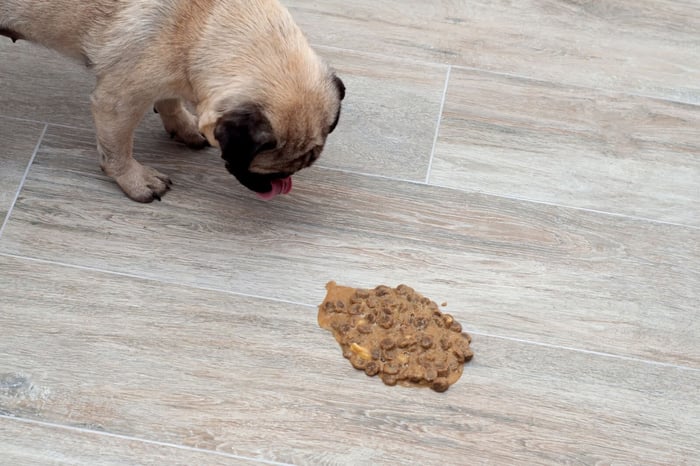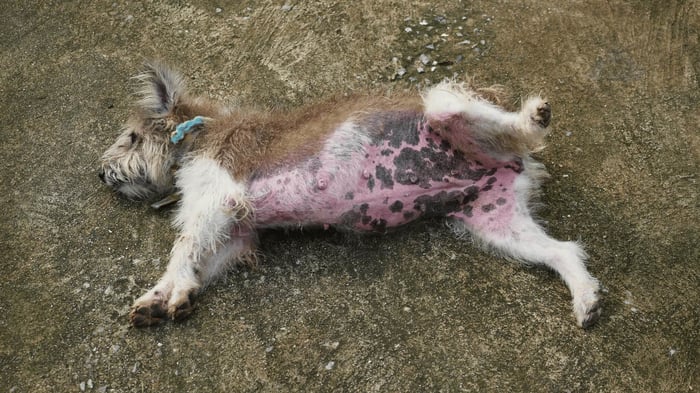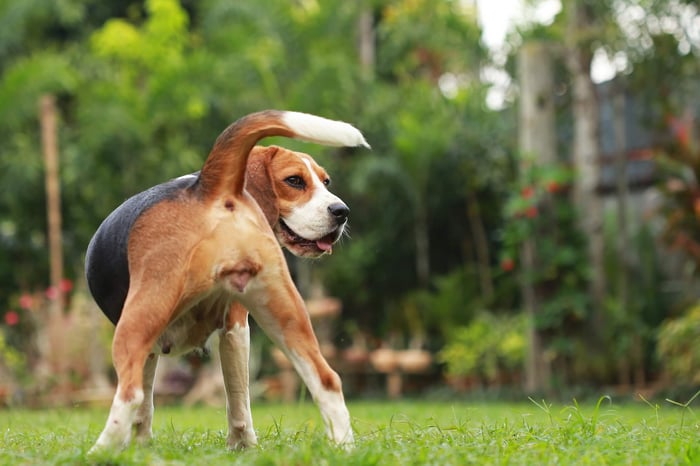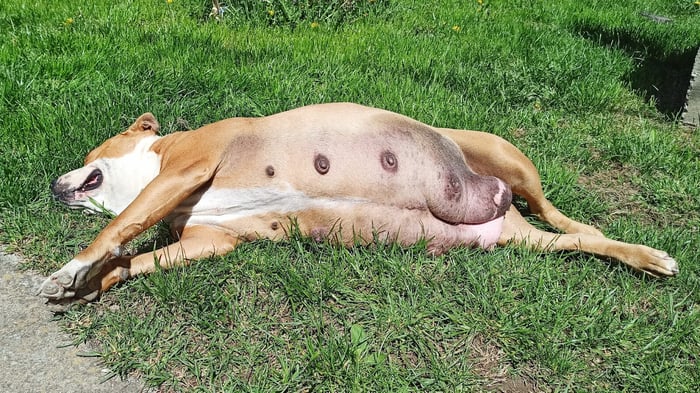A dog throwing up after eating can be an alarming sight. But how do you know why your dog is throwing up after eating? Is it dangerous? Is it something you can diagnose without a vet?
It all depends on how close an eye you can keep on your pup. As with anything to do with the canine digestive tract and what comes out with it, we suggest you first arm yourself with a dog stain and odor cleaner and some canine probiotics for their gut health.
To help you figure out what to do, we’ve consulted our medical sources on canine emesis as a symptom in various health conditions. So let’s dive into exactly why your dog or puppy may be vomiting after eating.
So, Why is Your Dog Throwing Up After Eating?
There are many reasons for vomiting or emesis after eating dogs. Usually dogs vomit after eating too much, too quickly, or eating something bad. Dogs may also vomit after eating due to gastritis (stomach inflammation), IBD, gastric neoplasia (abnormal growths in the stomach), ulcers, liver or kidney disease, spleen issues, pancreatic diseases.
Understanding why & how dogs vomit
According to studies, when dogs vomit, it’s because their body has a special system that helps them get rid of things that might be harmful or not good for them. It’s like their body’s way of protecting them with a reflex. The process of vomiting is a reflex controlled by a part of their brain stem that we will call the “vomiting center.”
The vomiting center in their brain sends signals to different parts of their body to make vomiting happen. These signals make their muscles contract in a coordinated way, starting from their stomach and going all the way up to their mouth. This squeezing motion helps push out the things that need to come out.
The vomiting center also makes sure that the vomit doesn’t go into the wrong places, like their lungs. It does this by controlling the timing and strength of the muscle contractions so that the vomit goes out of their mouth and not down into their lungs.
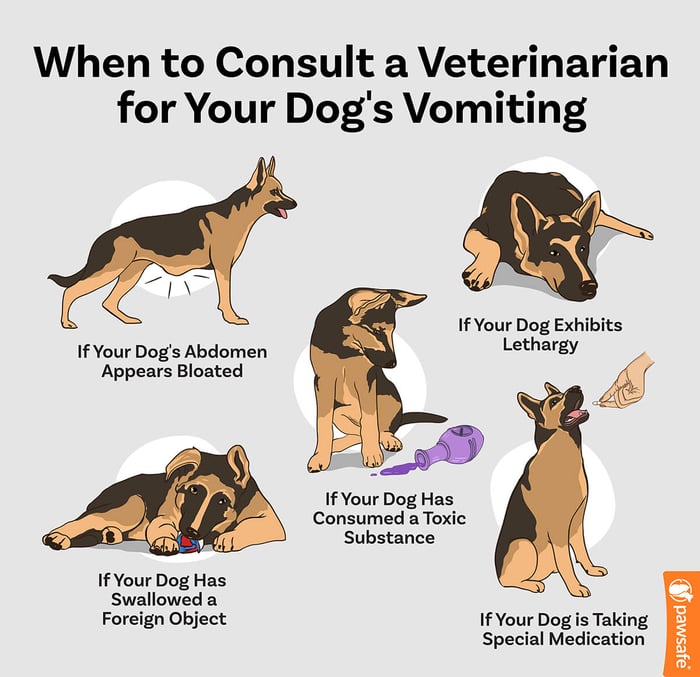
So, when a dog vomits, it’s because their brain is telling their body to get rid of something that could be harmful. It’s a protective reflex that helps keep them safe.
Phases of Vomiting in Dogs
When a dog starts to vomit, you might notice a few visible phases happening:
- Hypersalivation: This means that the dog’s mouth starts producing a lot of extra saliva. It might look like they are drooling more than usual. This increased saliva helps to protect their throat and esophagus from the stomach acid that comes up during vomiting. You may also notice their mouth foaming before they vomit if they are breathing heavily.
- Retching and dry heaving: Retching is when the dog’s stomach and chest muscles start to squeeze and tighten. It’s like they are trying to push the contents of their stomach upward. This action helps to move the things in their stomach closer to their mouth, preparing for expulsion.
- Expulsion: In this phase, the dog’s stomach and abdominal muscles contract strongly and push the contents of the stomach out through the esophagus and mouth. This is when the actual vomit comes out.
Understanding Vomiting vs. Regurgitation When Dogs Vomit After Eating
Vomiting and regurgitating are two different ways that dogs can bring up food or liquid, and they have distinct characteristics. It’s important to know if your dog is vomiting or regurgitating after eating, as vomiting is a much more serious sign of a health problem than regurgitation.
Vomiting is an active process that involves forceful contractions of the stomach muscles and the expulsion of stomach contents. It typically starts with retching or heaving, and the dog may show signs of discomfort or nausea beforehand. Vomit usually contains partially digested food, stomach fluids, and bile. It is often accompanied by other symptoms like drooling, pacing, or restlessness.
Regurgitation, on the other hand, is a passive process where food or liquid comes up from the esophagus or throat without any effort or abdominal contractions. It happens soon after eating, often within minutes, and the expelled material looks relatively undigested and cylindrical. Regurgitation is usually effortless and does not cause discomfort or retching. It may be accompanied by swallowing difficulties or regurgitation of undigested food from previous meals.
Dogs have a resilient gut and a remarkable immune system, but they aren’t immune to food poisoning and other diseases. The main challenge is to figure out exactly why they vomited after eating.
18 Most Common Reasons for Vomiting in Dogs After Eating
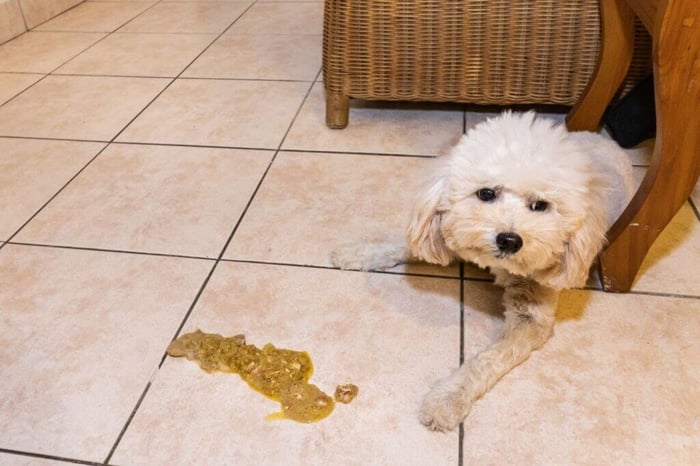
Vomiting in dogs after eating can have various causes and some are more serious than others, so let’s go over the main reasons a dog may throw up or regurgitate their food.
Remember, dogs can also vomit from viral infections like parvovirus (parvo), which is a highly contagious viral disease that primarily affects puppies. While vomiting is one of the symptoms, it is typically accompanied by other severe symptoms such as diarrhea, lethargy, loss of appetite, and dehydration. Parvovirus can be life-threatening, so immediate veterinary attention is crucial if you suspect your dog may be infected. If your dog won’t stop vomiting and presents other symptoms, see a vet immediately to catch any underlying viral or bacterial infections early.
1. Overeating
One of the most common reasons why dogs throw up after eating is overeating. Dogs that eat too much food or eat too quickly can experience an upset stomach and vomiting. This is especially true for dogs that are prone to obesity or have a history of digestive problems.
A simple way to deal with this is to feed your dog smaller meals in a slow feeder or freezing their food on lick mat.
2. Food Allergies & Intolerances
Another reason why dogs may throw up after eating is due to food allergies or intolerances. Dogs can develop sensitivities to certain ingredients in their food, such as wheat, soy, or corn. This can cause vomiting, diarrhea, and other digestive issues. In severe cases, dogs may even suffer from anaphylaxis, which is a life-threatening allergic reaction.
3. Eating Too Quickly
Dogs that eat too quickly can also experience vomiting after eating. When dogs eat too quickly, they may swallow air along with their food, which can cause digestive upset and vomiting. This can be especially problematic for dogs that are prone to bloating or have other digestive issues.
4. Dietary Changes
Dogs that are switched to a new diet or have their diet changed suddenly may also experience vomiting after eating. This is because their digestive system may not be used to the new food, and it may take some time for their body to adjust. Dietary changes can also cause dogs to poop a lot more or to have soft stools.
5. Ingesting Toxins Or Rancid Food
Dogs that ingest toxins, such as household cleaning products, plants, or medications, can also experience vomiting after eating. This is because the toxins can irritate the stomach lining and cause digestive upset.
Food that is off or stale, or rancid substances a dog may eat (such as poop) may also cause dogs to vomit.
6. Eating Foreign Objects
Dogs that eat foreign objects, such as toys, bones, or rocks, can also experience vomiting after eating. This is because the object can get stuck in their digestive system and cause irritation and inflammation.
7. Regurgitating Food For Puppies
Dogs often regurgitate food if there are puppies around. Puppies like to like the mouths of older dogs as a submissive signal, but it’s also a way of asking the older dog (usually their mother) to feed them. This can sometimes lead to unrelated dogs regurgitating the undigested food they just ate for any nearby puppies. This is a natural process that helps them digest their food more easily and is not a cause for concern.
8. Inflammatory Bowel Disease
Dogs that suffer from inflammatory bowel disease (IBD) may experience vomiting after eating. IBD is a chronic condition that causes inflammation in the digestive tract, which can lead to vomiting, diarrhea, and other digestive issues.
Overall, there are many reasons why dogs may throw up after eating. By understanding these common causes, pet owners can take steps to prevent vomiting and ensure their dog’s digestive health.
9. Gastritis
Gastritis happens when the lining of a dog’s stomach becomes inflamed or irritated. According to medical sources, it can be caused by things like eating spoiled food, ingesting foreign objects, or certain viral or bacterial infections like parvovirus. When a dog has gastritis, their stomach gets upset, and vomiting can be a way for their body to get rid of what’s causing the irritation.
10. Stomach Ulcers
Ulcers are sores or wounds that can form in the stomach or intestines. They can occur due to certain medications, infections, or other factors. Ulcers can make a dog’s stomach ache and cause them to vomit after eating.
For stomach ulcers, you may also see dark tarry, or dark red poop.
11. Intestinal blockages and Bloat
Dogs may also vomit after eating due to intestinal blockages, which occur when something gets stuck in the intestines and prevents food from passing through. Bloat, also known as gastric dilatation-volvulus (GDV), is another cause, where the stomach becomes enlarged and twisted. These conditions require immediate veterinary attention.
12. Gastric Neoplasia and Tumors
Just like people, dogs can also develop abnormal growths or tumors in their stomach or other parts of their digestive tract. These growths can disrupt the normal functioning of the digestive system, leading to vomiting after eating. Studies on gastric carcinoma list vomiting as one of the main symptoms so if your dog is chronically struggling to hold down their food, make sure to see a vet.
Dogs with severe stomach disorders like tumors, may also become incontinent and poop in their crates or not go outside to poop.
13. Pyloric Stenosis
Pyloric stenosis is a condition where the opening between the stomach and the small intestine becomes narrow or blocked. This narrowing can make it difficult for food to pass through, leading to vomiting shortly after eating. Dogs with this condition may need special treatment to widen the opening.
According to studies, pyloric stenosis is something you see most often in young, short-nosed breeds like Pugs or small Bulldogs. Dogs with this issue often vomit several hours after eating.
14. Liver Disease
The liver is an important organ that helps with digestion and filtering toxins from the body. When a dog’s liver is not working properly due to disease or damage, it can affect their digestion and cause vomiting after eating.
15. Kidney Disease
The kidneys help filter waste products from the blood and regulate water balance in the body. If a dog has kidney disease, toxins can build up in their system, affecting their overall health and causing symptoms like vomiting.
16. Spleen Issues
The spleen is an organ that helps filter the blood and fight infections. Certain conditions, such as an enlarged or ruptured spleen, can cause vomiting in dogs after eating. This requires medical attention.
17. Pancreatic Diseases
The pancreas produces enzymes that aid in digestion. If the pancreas becomes inflamed (pancreatitis) or develops other problems, it can lead to digestive issues, including vomiting after meals and you may even see maldigestion signs like green poop.
18. Urogenital Disease
Problems in the urinary or reproductive system, such as urinary tract infections or bladder stones, can sometimes cause dogs to vomit after eating. These issues need to be addressed by a veterinarian.
Acute vs. Chronic Vomiting
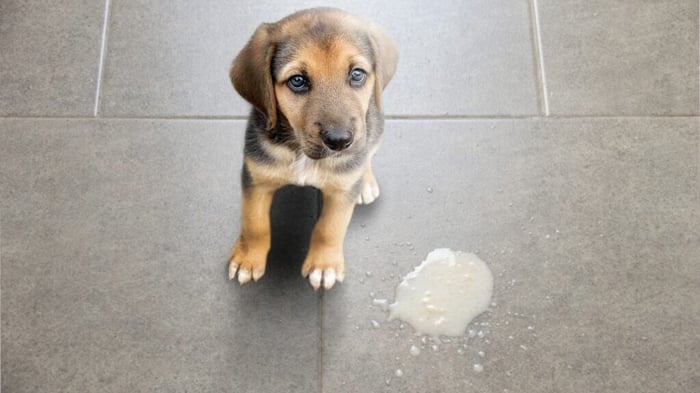
Acute vomiting
Acute vomiting is when a dog throws up suddenly and without warning. This can be caused by a number of factors, including eating too quickly, eating something that doesn’t agree with them, or overeating. Acute vomiting is usually not a cause for concern and can be resolved with simple changes to the dog’s diet and eating habits.
Chronic vomiting
Chronic vomiting, on the other hand, is when a dog throws up on a regular basis. This can signify a more serious health issue, such as an infection, kidney disease, or cancer. If a dog is experiencing chronic vomiting, it is important to take them to the vet for a thorough examination and diagnosis.
Regurgitation vs. Vomiting in Dogs
Regurgitation
Regurgitation is when food or liquid comes back up from your dog’s throat and is spit out without much effort. It happens right after eating or drinking and looks similar to what they had.
can happen because of problems with the throat or a condition called megaesophagus. If your dog keeps regurgitating or has trouble swallowing, see a vet.
Vomiting
Vomiting, on the other hand, is when the stomach forcefully pushes out its contents. It’s like when you throw up after eating something bad. Vomit is a mix of food, stomach stuff, and sometimes bile. Dogs might show signs of feeling sick before throwing up, like drooling or acting restless.
Note: Many things can cause vomiting, like eating something they shouldn’t, infections, tummy inflammation, or even serious illnesses. It often causes bad breath, which can indicate further health problems.
8 Signs and Symptoms to Watch Out For When Your Dog Is Vomiting After Eating
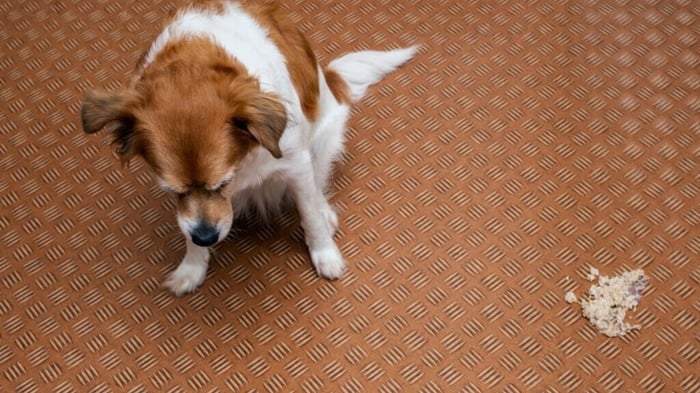
When a dog vomits shortly after eating, it can be concerning. Here are some signs and symptoms to watch out for if your dog experiences vomiting after eating:
- Frequent or Persistent Vomiting: If your dog vomits consistently after every meal or if the vomiting continues for an extended period, it may indicate an underlying issue that requires attention.
- Changes in Appetite: Notice if your dog’s appetite has decreased or if they show disinterest in food. A sudden loss of appetite accompanied by vomiting can signify a more significant problem.
- Abdominal Discomfort: Watch for signs of abdominal discomfort or pain. Your dog may display restlessness, whining, or tenderness in the belly area.
- Lethargy or Weakness: Vomiting can leave dogs feeling weak or tired. If your dog seems unusually tired or lacks energy, it could be related to the vomiting.
- Diarrhea: Pay attention to any changes in bowel movements. Frequent diarrhea, along with vomiting, may indicate a gastrointestinal issue.
- Dehydration: Vomiting can lead to fluid loss, so monitor your dog for signs of dehydration. These may include dry gums, excessive thirst, sunken eyes, or a loss of skin elasticity.
- Blood in Vomit: If you notice blood in your dog’s vomit, seeking immediate veterinary attention is essential as it could indicate a serious condition.
- Weight Loss: Unintentional weight loss can occur if your dog consistently vomits after eating and cannot keep food down.
If you observe any of these signs and symptoms, it is important to consult a veterinarian. They can assess your dog’s health, determine the underlying cause of the vomiting, and recommend appropriate treatment.
What To Do When Your Dog Is Vomiting After Eating
1. Remove Food and Water
2. Monitor Your Dog
3. Check for Foreign Objects
4. Give Your Dog a Break
5. Offer Small Amounts of Water & Electrolytes
6. Gradual Reintroduction of Food
7. Contact Your Veterinarian
Frequently Asked Questions (FAQs)
Why is my dog throwing up undigested food hours after eating?
My dog is throwing up everything he eats and drinks, why?
My dog is throwing up undigested food, treatment?
My dog is throwing up food but still pooping?
Help, my dog is throwing up undigested food after drinking water
It’s essential to take them to a veterinarian for a check-up to determine the cause of the vomiting and provide the necessary treatment.
When should you be concerned about your dog throwing up?
Why do dogs eat their own vomit?
Dogs also have a strong sense of smell and may be drawn to the odor. Sometimes, dogs eat their vomit out of anxiety or fear, wanting to clean up quickly. While it may seem gross to us, this behavior is relatively common in dogs and usually not a big concern.
However, if it happens frequently or is accompanied by other signs of illness or distress, it’s best to check with a vet to make sure everything is okay. They can provide guidance and determine if there are any underlying health issues or behavioral problems that need to be addressed.
Conclusion
Dealing with a dog that throws up after eating can be concerning, but understanding the causes, symptoms, and appropriate actions can help you navigate the situation. If the vomiting persists or accompanies worrisome symptoms, don’t hesitate to seek veterinary attention. Stay informed and care for your four-legged friend’s health to ensure they lead a happy and healthy life.


